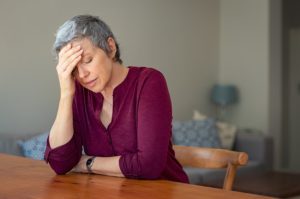 Many conditions can lead to bone loss. New research shows how stress can be an essential factor when looking at possible risk factors. According to the study published in the Journal of Epidemiology & Community Health, poor quality social relationships that contribute to psychosocial stress may be related to bone loss in postmenopausal women.
Many conditions can lead to bone loss. New research shows how stress can be an essential factor when looking at possible risk factors. According to the study published in the Journal of Epidemiology & Community Health, poor quality social relationships that contribute to psychosocial stress may be related to bone loss in postmenopausal women.
Stress has been proven in previous studies as a well-established risk factor for many chronic diseases. Psychological stress, such as increased significant life events, life satisfaction, lower levels of optimism, and education may all be associated with fractures.
Advertisement
Psychosocial stress is the physiological and emotional reaction experienced when a situation arises, and an individual goes beyond their coping resources. Other stressful situations that have been known to push individuals’ stress levels are martial problems, abuse, death of a loved one, health problems, and financial crises.
A Decline in Bone Mineral Density
For this study, the premise was that psychosocial stress might increase fracture risk because of a decline in bone mineral density (BMD). The authors suggested that stressors may alter BMD through changes in hormone levels. This can include thyroid hormones, cortisol, growth hormone, and glucocorticoids.
Previously, very few studies have studied the relationship between stress and BDM. This was the driving motivation of this research team to find a connection. The data was collected from 11,020 postmenopausal women who were enrolled in the Women’s Health Initiative (WHI). The WHI is a long-term US health study launched in 1993 to assess strategies for preventing heart disease, colorectal and breast cancer, and osteoporotic fractures in postmenopausal women.
The data that was used for this study had been collected at the time of enrolment and a follow-up visit six years later. The women were required to complete a questionnaire at enrolment, which included information regarding stress. This included social support, which measures positive relationships; social strain, which measures negative social interactions and relationships; and social functioning, which looks at limitations in social activity
The research showed that there was a link between social stress and lower BMD over six years. This was concluded after adjusting for potential influencing factors such as age, education, existing conditions, smoking status, alcohol use, hormone therapy use, age at menopause, physical activity, history of fracture after age 55, and weight.
The authors said, “We identified specific psychosocial stressors pertaining to the social environment that were associated with bone loss.”
It was also found that after the six-year follow-up, the higher social strain was associated with a lower BMD of the hip, femoral neck (just below the ball of the ball-and-socket hip joint), and lumbar spine (lower back). Social functioning stress was connected with more significant bone loss at the total hip and femoral neck.
Advertisement
The authors of the study point out that this is an observational study and therefore can’t establish cause and that psychosocial stress levels may have been lower than average because participants in the Women’s Health Initiative were healthy individuals living in the community. Also, the psychosocial stress levels were self-reported at the start of the study and could have changed over the follow-up period.
However, the authors of the study did conclude, “We found that bone loss is among the physiological stress responses more strongly related to the quality of social relationships than quantity. The results support community building social stress interventions in postmenopausal women to potentially limit bone loss.”
Also read:
- 15 bone strengthening exercises for strong bones
- Osteoporosis fractures: Exercises and their benefits in reducing bone fracture risk
